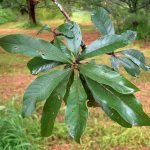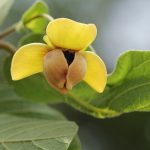TREE LIFE
MARCH 1989
MASHONALAND CALENDAR
Tuesday 7th March : Botanic Garden Walk at 1650 hours for 1700 hours.
Sunday 19th March : Zanka Farm, Beatrice. A very interesting Kalahari sand area where we shall see several species which are peculiar to this type of soil.
We are hiring a bus for this outing and the fare will be $19. The bus leaves the Monomatapa car park at 0830 sharp. There will be a guard to look after the cars. Please book by phoning Joy Killian on 308398 by no later than Thursday 16th March.
Saturday 25th March : Easter weekend so no Mukuvisi walk.
Tuesday 4th April : Botanic Garden Walk.
15th – 19th April Outing to Kariba : Accommodation has been booked at the MOTH Cottages for this period and there are a few vacancies still to be filled. Interested members please contact Maureen Silva Jones or write to P.O.Box 2128, Harare. Cost $50 per person for the whole period. Transport –own cars. Messing – Own food and drinks to be taken. Other items – Bring own towels. All other items are provided.
MATABELELAND CALENDAR
Sunday 5th March : We will go to the Togwana area of the Matopos. Meet at 0830 hours at Retreat.
Sunday 2nd April : We are going to the Fort Rixon area to Makovani Estate, Mr. S. Schur. Meet at Ascot Car Park at 0830 hours.
MATABELELAND NOTES
On Sunday February 5th we went to Hillside Dams near the Aloe Garden. Our Chairman, Ken Blake had devised an excellent scheme of “Tree Bingo” using a group of old field cards of the area. After a fairly hectic couple of hours, Joanna Humphrey completed her card and became the winner of an attractive Olive wood artefact. The scheme was also an effective vote catching idea as at the following Annual General Meeting all officials were re-elected! We identified some 64 tree species in two hours, which was good going, but some 10 species which we knew to be there, were not apparently on our immediate route. However, the Bingo was a great success and hopefully we will try it again, later, in a well researched area as is required. Of interest were Acacia ataxacantha, A. galpinii, A. karroo in full golden yellow flower, A. nigrescens with leaflets more pointed than usual.
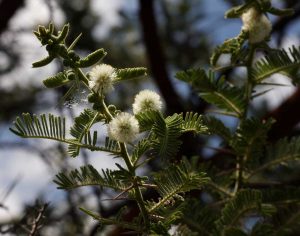
Acacia rehmanniana. Photo: Bart Wursten. Source: Flora of Zimbabwe.
A. rehmanniana in full white flower, some very white leaved Brachylaena rotundata, Canthium lactescens, Cassine transvaalensis, many Celtis africana, Commiphora mollis, C.schimperi, Dovyalis caffra, Ehretia rigida, erythrina latissima, Ficus glumosa, F. sur, F. thonningii, Grewia flavescens, many G. monticola, few Kirkia acuminata, seeding, Lannea discolour, L. schweinfurthii (Stuhlmanni), Maytenus senegalensis, M. undata, Olea europaea subsp. Africana, Ozoroa insignis subsp reticulata, Pappea capensis, quite a few all with rather long leaves, Pavetta gardenifolia, Pterocarpus angolensis, seeding, Rhoicissus tridentata, Rhus lancea, R. leptodictya, Schrebera alata, Sclerocarya birrea many, Securinaca virosa, snowberry (now Flueggea virosa), Strychnos spinosa, Tarchonanthus camphoratus, Vangueria infausta, Vitex payos.
C. Sykes.
BOTANIC GARDEN WALK FEBRUARY 1989
This month Tom Muller led us around the high altitude rain forests of Inyangani as a review of our visit to the Trace’s property, Nyazengu, in December. The walk began at the base of the new stream where there is a young Afrocrania volkensii with its pale green opposite leaves that have light veins. This species only grows in wet areas usually at 1500 – 2000m although its associates are dryer adapted species like Prunus africanus, Ilex mitis, Calpurnia aurea with an understorey of Peddiea africana and Psychotria zambamontana (sounds just like Nyazengu where we saw them lining the rivers). From above they have a distinct architecture with a pale, layered canopy. Tom showed us that when the leaf is snapped and pulled apart many silky threads develop. Similar threads also occur in Maytenus acuminata and Cassine eucleiformis. Elsie Esterhuizen of the Bolus Herbarium (a delightful character who was always able to leap up a mountain faster than myself despite the fact that she was born before WW1) suggests that these are the elastic thickenings of the tracheids (cells that transport water). Afrocranea belongs to the CORNACEAE along with Curtisia (we saw C. dentata later in the walk as it also grows in the same forests). Cronquist states that in the CORNACEAE, the xylem vessels often have scalariform (ladder like) thickening. I checked C. dentata and found that is also produces silky threads although these are confined to the midrib and lateral veins. Other family features include a woody habit with simple leaves without stipules. Other family features include a woody habit with simply leaves without stipules. Both A. volkensii and C. dentata have opposite leaves although in the first the margin is entire, in the latter it is very dentate. Cronquist places the CORNACEAE in the Cornales, an order derived from the Rosales. Although they often have iridoid compounds neither of these species turn black when pressed, all the herbarium specimens dry to green or brown.
I am sure that armed with this write-up anyone should be able to follow our path through the area, the specimens are close together and fairly well labelled. Alongside Afrocranea is a male Ilex mitis with a perverse horizontal branch that links two of the trunks in a strange manner. It showed the distinct chlorotic (patchy yellow) leaves that produce a yellow lather when crushed and rubbed with water. Erythrococca polyandra (EUPHORBIACEAE) has a pale bark and thin alternate leaves with serrated margins, it is a common understorey shrub. Syzygium quineense subsp gerrardii (= subsp. afro-montana) is another riverine tree to about 1700m above this it is replaced by S. masukuense (Tom would like seedlings or seeds of this species, it is difficult to grow). Still at the base of the new stream on the left of the path is Psychotria zombamontana which we had trouble with at Nyazengu. By comparing it with P. mahonii that grows alongside Trilepisium at the old stream, the differences are as striking as Tom originally stated. P. zombamontana has 10 – 18 pairs of lateral veins, no hairs on the finest branchlets and leaves usually shorter than 15cm. P. mahonii has 7 to 12 pairs of lateral veins, hairs on the youngest branchlets and the leaves are longer than 14cm. It grows at lower altitudes and so we would not expect to see it at high altitudes. The other species, P. capensis, grows next to the Newtonia between the two Ficus vallis-choudae opposite the lake. Despite what the good book says I have never found black dots in the leaves of Psychotria. Pittosporum viridiflorum is present but not common at altitudes up to 2000m. Peddiea africana is a common understorey shrub from coastal forests to the slopes of Inyangani. Piper capensis is commoner lower down (Bunga) but can occur at high altitudes whereas Clausena anisata ranges from high to low altitude forests. Dovyalis lucida with its shiny leaf is another understorey tree and is present although not common at the highest altitudes. Just before turning left up the embankment there is a
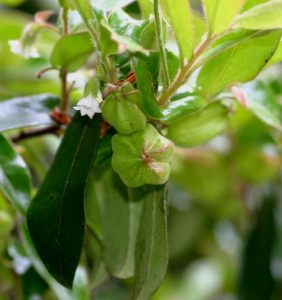
Diospyros whyteana. Photo:Bart Wursten. Source: Flora of Zimbabwe
Diospyros whyteana next to the stream. The fringe of rusty hairs along the leaf is distinct; the tree can grow to 20m tall with Afrocrania. Along the side of the path we saw the fireball Haemanthus and the shade grass Oplismenus. Kiggelaria africana grows from the slopes of Table Mountain to the heights of Inyangani alongside Afrocrania. It is often a sign of early succession and invades old habitation sites along with Hypericum revolutum, Myrica, Massa lanceolata and Cassinopsis tinifolia. Prunus africanus is distinct as it is one of the few rough barked trees in these forests. Tom is keen to have seedlings of two RUBIACEAE: Canthium oligocarpum which has no spines and pale veins, it is rare but always present in these forests, and Pauridiantha symplocoides which we saw in December alongside the Nyazengu River on the way to the cascading waterfall. On the right of the path is Maytenus mossambicensis which is more delicate than M. heterophylla and is a shrub in these forests. Podocarpus latifolius is a tall canopy tree even at the highest altitudes. Moving off the path towards the stream we found Oxyanthus speciosus which resembles Psychotria but has stiff leaves and broad stipules. It is a small tree often with a twisted trunk (this needs checking again). Apparently Rhus chirindensis can form a strong rope like liana in these forests. Halleria lucida has showy red flowers on the main stems and Schefflera umbellifera is a common pioneer along the forest margin. Nuxia congesta has leaves in threes and grows as a wind swept shrub at World’s View but as a tree in the Vumba forests. We also found it at Saffron Walden (see Tree Life, No.45). Continuing past the Nuxia and turning left and left again takes one to a Syzygium masukuense on the right. These often grow in dense stands with buttress roots and pale bark – for example in the steep forest along Nyazengu Ridge, it has no petiole and big fruit. Croton sylvaticus grows from Chirinda Forest to Nyazengu Ridge. Cryptocarya liebertiana has asymmetric leaves that are often red. It is common with Pterocelastrus above the Tea Estates but is rarer at higher altitudes.
Backtracking and heading out of the forest we found Cassinopsis ilicifolia. There is a lot of this spiny liana in that forest close to the car park at Inyangani. It may grow in dry forest with C. tinifolia. Naoboutonia melleri is now split into three species (we need to re-examine this sometime). Along the forest edge Tom has Rapanea melanophloes which has a slash like streaky bacon. Backtracking again we passed Widdringtonia nodiflora and Aphloia theiformis which has a pale bark and can grow to 40m in the Pungwe Valley. Entering the forest we passed Maesa lanceolata and tall Catha edulis which are pioneers at Cecil Kop but do not grow at Inyangani. Walking up the stepping stones in the river and turning left we found Curtisia dentate on the left of the path (see note on CORNACEAE at the beginning). Strelitzia nicolai grows from coastal forest to high altitudes (we saw it at Nyazengu) and Polyscias colonizes disturbed areas. The Salix in the river comes from Nyanga. Crossing the river at the Strelitzia we saw Calpurnia aurea to the left (this is cultivated as a garden plant, it needs extra water). We passed Olea capensis (rare at Nyanga), a Tabernaemontana stapfiana (can grow at high altitudes) and Chionanthus foveolatus.
All in all an intensive walk and one that still needs further digestion. Thanks Tom, we appreciate your time.
Kim Damstra.
OUTING ON 19TH FEBRUARY 1989 – KLEIN KOPJES FARM, CONCESSION
What can we say about a day spent with a charming hostess and host on a most attractive farm with a beautiful garden? And nearly ninety tree species identified during the day. Is fantastic the word I am looking for? Can’t think of a better one. We were joined by the Aloe Cactus and Succulent Society and were very happy that so many accompanied us on our ramble through the woodland. We picked their brains of course, and they showed us Aloe greatheadii, A. zebrina (flowering) and A. christianii. Once again a new aspect of the bush was opened up to us. This day the writer dogged Kim Damstra, who showed us many things that not all of us knew about. Take, for instance, the family FLACOURTIACEAE. Twelve generally are represented in this country and they share several common identifying features. The leaf margins are invariably serrated. The leaves are always alternate. Three to five main veins appear to arise from the base of the leaf, the lateral ones rising at an acute angle to the centre vein. We noted all these features on the leaves of Dovyalis zeyheri and also noted the “race track” marks left by the leaf miner which enters the base of a leaf as a tiny grub from eggs laid on the surface, and then chomps his way through the length of the leaf to emerge eventually as a mature insect which mates and starts the whole process again. We went through a somewhat sticky patch when we found Azanza garckeana and the topic of the mucilaginous properties of its fruit and of other parts of other genera of the MALEACEAE family (Abutilon, Hibiscus) were discussed. On then to the elusive
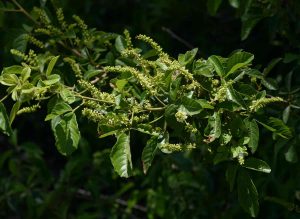
Allophylus africanus. Photo: Bart Wursten. Source: Flora of Zimbabwe.
Allophylus africanus – elusive as it is so often confused with Rhus sp. both having compound, trifoliolate leaves. What make Allophylus distinctive? Well, one lateral leaflet is often smaller than the other. Then there is the resinous smell that Rhus has, but Allophylus not. Lastly, there is the propensity of Allophylus to having small pockets of hairs in the axils of the veins on the underside of the leaf. With such clues there can surely be no excuse for not knowing your Allophylus from your Rhus engleri.
So much more! The young branchlets of Acacia gerrardii, for instance, are covered with grey velvety hairs. But so are those of A. rehmaniana. A close look at the former, however, confirms its identity. It has many small, golden brown lenticels showing quite clearly through the grey fuzz. Last month we wrote of a pulvinus mechanism at work to twist leaves to or away from the sun as the case may be. Today we saw the system in operation in a small species of sorrel, where a touch causes the leaflets to fold downwards along the rachis, thus causing the plant to almost disappear when viewed from above. After a little while the plant resumes its normal shape, all thanks to the pulvinus. And so another wonderful day slipped by. Thank you, Nikki and Ian Bates, for letting us all enjoy your lovely homestead.
TREE MAPPING
Distribution records of trees in Zimbabwe are rather scanty. The Tree Society are proposing to try to remedy the situation through undertaking a tree mapping exercise. This will be done on the basis of areas known as “quarter degree” squares (QDS).
There will be a map of Zimbabwe for each species, divided into quarter degree squares (as illustrated) and a master list of species recorded for each quarter degree square. Tree cards, including the names of over 800 species have been drawn up and the maps prepared.
For these maps and lists to be acceptable, the information they contain must be accurate. In order to achieve accuracy the observer must know in which quarter degree square the trees are being recorded and must be quite sure of the identification of each species.
Neither objective is too difficult.
Maps are obtainable (ref: Zimbabwe 1:1,000,000 Relief) which the degrees of latitude and longitude clearly marked and the degree squares divided into 16 smaller squares, each of which is known as a quarter degree square and in fact represent the area covered by a 1:50,000 map; i.e. about 28km (N to S) by 27km (E to W). For convenience the 1:250,000 maps give a very good scale although it is necessary to draw in the lines for the quarter degree squares (there are markers to show where the lines should be). All these maps cost only $2,00 each and are obtainable from the Department of the Surveyor General, P.O.Box 8099, Causeway or Electra House, Samora Machel Avenue, Harare. There is a map attached to these notes showing some of the quarter degree squares around Harare. The Ornithological Association of Zimbabwe have given names to the quarter degree squares and we have their permission to use the same names for our project, for which we thank them. By using a name as well as a number on the field card, there is a check that the correct square has been recorded. There are over 600 QDS’s so the names are not included here but lists are available for anyone who wants them.
With regard to identification, if in doubt put a question mark “?” and send or bring a specimen for identification in to the National Herbarium. Following this are hints on the collection of plant specimens for identification.
Where two or more subspecies or varieties occur in the country subsp. or var. have been included after the botanical name. This is to save space instead of listing them all. We feel that it is an excellent opportunity for us to become familiar with the different vars. and subspecies as well as to see if they are distinct in the field. In order to achieve this the variety or subspecies must be filled in for all the relevant species. A review of these subspecies and varieties is included in this newsletter.
To save space, a full list of the species of Cyathea and Encephalartos have not been included. Instead there is a row of dots ………. for the specific name to be completed.
Other information required on the card is : HABITAT – woodland / riverine/ rocky /grassland /forest hillside / flat; SOIL- red /sand / gravel / black; DATE and name of observers.
We would appreciate as many members as possible participating in this project. There is a lot of work to do. Not only recording trees in the field, but also transferring the information to the maps from the field cards and updating the master copies of lists for each square.
HINTS ON THE COLLECTION OF PLANT SPECIMENS FOR IDENTIFICATION
For plants to be reliably identified adequate material is necessary. Poorly preserved scraps are not good enough. Specimens should preferably be collected when the plant is in flower or fruit and only in exceptional circumstances should sterile material be submitted. Adequate material specimens consists of twigs with leaves and flowers and/or fruits and all showing variation of size, to fit an area slightly smaller than the size of 30 x 45cm (more or less the size of a sheet of The Herald folded in half). Where possible several (up to 3) such specimens of each plant should be made for retention by the National Herbarium if desired.
For the preparation of good specimens :
(i) the plants should be pressed before they begin to wilt
(ii) newspaper can be used to dry the specimens; the paper should, ideally, be changed everyday until the plants are dry; this is important otherwise plants are likely to become mouldy and/or loose their leaves; if a press is used it can be put in the sun or near artificial heat to hasten the process. It is quite a good idea to put each specimen in a single sheet of paper with a double sheet or piece of corrugated cardboard between them
(iii) it is important to get the specimens really flat so it is necessary to press the plants under pressure. If no press is available, they could be put under a mattress providing the bed has a solid base, or under a piece of wood or still cardboard with a weight of stones, bricks or books on top. A simple press can be made by nailing slats of wood together so that they criss cross. The outside should be about the size of the Herald folded in half.
Data should be entered in a field notebook and a copy of the information should accompany the specimen. This should include :
(1) Name of collector
(2) Number of specimen. Every collector should have his own series of collecting numbers and each specimen should be numbered using a jeweller’s tag or by putting the number on the newspaper so that the specimen can be related to the data
(3) Date of collection
(4) Locality, district; 1/4 degree square degree grid reference if known, or direction and distance from some well known place, so that the plant can be found again
(5) Habitat/ecology. The sort of place in which the plant was growing, e.g. miombo woodland on sandy soil
(6) Altitude
(7) Description of the plant which will not be apparent in the pressed specimen, i.e. height, trunk diameter, appearance of bark, presence of thorns, colour of leaves, flowers as a whole and/or sepals, petals, stamens etc.; scent of flowers, leaves etc.
(8) The vernacular name/s and any uses if known.
A REVIEW OF THE DIFFERENCES BETWEEN THE SUBSPECIES AND VARIETIES OF THREE SPECIES WHICH OCCUR IN ZIMBABWE
In drawing up the notes and lists of subspecies and varieties I have used the list prepared by Mr. Bob Drummond and many sources of literature including various volumes of Flora Zambesiaca, Flora of Tropical East Africa, Kew Bulletin, South African and Jeppe, Trees of Southern Africa by Keith Coates Palgrave. My thanks to Bob Drummond, Bryan Adams, Tom Muller, Jonathan Timberlake and Kim Damstra for their help. I really appreciated it.
-Meg Coates Palgrave
This very interesting comparison of the differences between the subspecies and varieties of tree species which occur in Zimbabwe has been placed under “Discover Trees” of this Web Site for easy access.
Editors Note
Phil Haxen has finally been relieved of the Editorship after many years of great service in this respect. Thank you, Phil, for keeping the show on the road for so long.
Dick Hicks has assumed the mantle, and hopes that members will keep him supplied with material so that the high standard set by Phil can be maintained.
DICK HICKS CHAIRMAN


